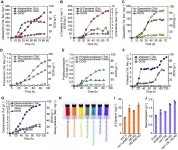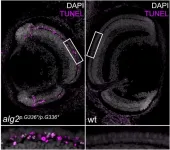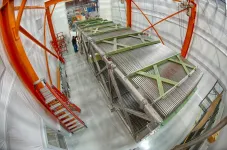Machine learning speeds up simulations in material science
Faster and more accurate methods come in useful in various applications from energy storage to medicines -- publication in Nature Materials
2021-06-09
(Press-News.org) Research, development, and production of novel materials depend heavily on the availability of fast and at the same time accurate simulation methods. Machine learning, in which artificial intelligence (AI) autonomously acquires and applies new knowledge, will soon enable researchers to develop complex material systems in a purely virtual environment. How does this work, and which applications will benefit? In an article published in the Nature Materials journal, a researcher from Karlsruhe Institute of Technology (KIT) and his colleagues from Göttingen and Toronto explain it all. (DOI: 10.1038/s41563-020-0777-6)
Digitization and virtualization are becoming increasingly important in a wide range of scientific disciplines. One of these disciplines is materials science: research, development, and production of novel materials depend heavily on the availability of fast and at the same time accurate simulation methods. This, in turn, is beneficial for a wide range of different applications - from efficient energy storage systems, such as those indispensable for the use of renewable energies, to new medicines, for whose development an understanding of complex biological processes is required. AI and machine learning methods can take simulations in material sciences to the next level. "Compared to conventional simulation methods based on classical or quantum mechanical calculations, the use of neural networks specifically tailored to material simulations enables us to achieve a significant speed advantage," explains physicist and AI expert Professor Pascal Friederich, Head of the AiMat - Artificial Intelligence for Materials Sciences research group at KIT's Institute of Theoretical Informatics (ITI). "With faster simulation systems, scientists will be able to develop larger and more complex material systems in a purely virtual environment, and to understand and optimize them down to the atomic level."
High Precision from the Atom to the Material
In an article published in Nature Materials, Pascal Friederich, who is also associate group leader of the Nanomaterials by Information-Guided Design division at KIT's Institute of Nanotechnology (INT), presents, together with researchers from the University of Göttingen and the University of Toronto, an overview of the basic principles of machine learning used for simulations in material sciences. This also includes the data acquisition process and active learning methods. Machine learning algorithms not only enable artificial intelligence to process the input data, but also to find patterns and correlations in large data sets, learn from them, and make autonomous predictions and decisions. For simulations in materials science, it is important to achieve high accuracy over different time and size scales, ranging from the atom to the material, while limiting computational costs. In their article, the scientists also discuss various current applications, such as small organic molecules and large biomolecules, structurally disordered solid, liquid, and gaseous materials, as well as complex crystalline systems - for example, metal-organic frameworks that can be used for gas storage or for separation, for sensors or for catalysts.
Even More Speed with Hybrid Methods
To further extend the possibilities of material simulations in the future, the researchers from Karlsruhe, Göttingen, and Toronto suggest the development of hybrid methods: these combine machine learning (ML) and molecular mechanics (MM) methods. MM simulations use so-called force fields in order to calculate the forces acting on each individual particle and thus predict motions. As the potentials of the ML and MM methods are quite similar, a tight integration with variable transition areas is possible. These hybrid methods could significantly accelerate the simulation of large biomolecules or enzymatic reactions in the future, for example.
INFORMATION:
Original publication:
Pascal Friederich, Florian Häse, Jonny Proppe & Alán Aspuru-Guzik: Machine-learned potentials for next-generation matter simulations. Nature Materials, 2021. DOI: 10.1038/s41563-020-0777-6
Abstract at https://www.nature.com/articles/s41563-020-0777-6
More information on the AiMat research group: https://aimat.science
More details about KIT Information, Systems, Technologies Center (KCIST): https://www.kcist.kit.edu
More about KIT Materials Center: https://www.materials.kit.edu
Contact for this press release:
Margarete Lehné, Press Officer, Phone: +49 721 608-41157, Fax: +49 721 608-41157, margarete.lehne@kit.edu
Being "The Research University in the Helmholtz Association", KIT creates and imparts knowledge for the society and the environment. It is the objective to make significant contributions to the global challenges in the fields of energy, mobility, and information. For this, about 9,600 employees cooperate in a broad range of disciplines in natural sciences, engineering sciences, economics, and the humanities and social sciences. KIT prepares its 23,300 students for responsible tasks in society, industry, and science by offering research-based study programs. Innovation efforts at KIT build a bridge between important scientific findings and their application for the benefit of society, economic prosperity, and the preservation of our natural basis of life. KIT is one of the German universities of excellence.
[Attachments] See images for this press release:

ELSE PRESS RELEASES FROM THIS DATE:
2021-06-09
A research team led by Professor Jianping Huang from Lanzhou University has launched a Global Prediction System for COVID-19 pandemic. Their recent work explored the periodicity and mutability in the evolutionary history of the COVID-19 pandemic and investigated the principle mechanisms behind them. They attributed the periodic oscillations of COVID-19 daily cases to seasonal modulations and reporting bias, and identified the unrestricted mass gatherings as the main culprit of the COVID-19 disaster.
Their findings, entitled "The oscillation-outbreaks characteristic of the COVID-19 pandemic", were published in National Science Review.
In this study, the influence ...
2021-06-09
Bristle worms are found almost everywhere in seawater, they have populated the oceans for hundreds of millions of years. Nevertheless, some of their special features have only now been deciphered: Their jaws are made of remarkably stable material, and the secret of this stability can now be explained by experiments at TU Wien in cooperation with Max Perutz Labs.
Metal atoms, which are incorporated into the protein structure of the material, play a decisive role. They make the material hard and flexible at the same time - very similar to ordinary metals. Further ...
2021-06-09
X-rays are widely used to study the structures of various objects. New sources of x-rays, like Free Electron Lasers and 4th generation synchrotrons are being built around the Globe. The best optics for the new sources is usually made of the single crystal materials, such as silicon, germanium or diamond. However, the ideal periodicity of crystals leads to some unwanted diffraction losses - X-ray glitches. This effect causes dips in the intensity of the radiation transmitted through the optical element, down to zero. Scientists from the Immanuel Kant Baltic ...
2021-06-09
Language is one of our species' most important skills, as it has enabled us to occupy nearly every corner of the planet. Among other things, language allows indigenous societies to use the biodiversity that surrounds them as a "living pharmacy" and to describe the medicinal properties of plants. Linguists estimate that there are nearly 7,400 languages in the world today.
Most of these languages, however, are not recorded in writing, and many languages are not being passed on to the next generation. This has led linguists to estimate that 30 percent of all languages will disappear by the end of the 21st century. For indigenous cultures who mostly transmit knowledge orally, this ...
2021-06-09
A research group at KAIST has engineered bacterial strains capable of producing three carotenoids and four violacein derivatives, completing the seven colors in the rainbow spectrum. The research team integrated systems metabolic engineering and membrane engineering strategies for the production of seven natural rainbow colorants in engineered Escherichia coli strains. The strategies will be also useful for the efficient production of other industrially important natural products used in the food, pharmaceutical, and cosmetic industries.
Colorants are widely used in our lives and are directly related to human health when we eat food additives and wear cosmetics. However, most of these colorants are made from petroleum, causing unexpected side effects and health problems. Furthermore, ...
2021-06-09
Feelings of anxiety, pessimism and depression during the COVID-19 pandemic led middle-aged women in both Australia and the UK to stock up on alcohol, which was associated with drinking more, a new Flinders University-led study has found.
The research, led by Dr Emma Miller in Flinders University's College of Medicine and Public Health, also found women in the UK were more likely to drink at risky levels than their Australian counterparts during lockdown, and were more likely to have stockpiled alcohol.
Despite these differences, the research found the emotional responses to ...
2021-06-09
Tsukuba, Japan - Ceramic materials that are resistant to cracking are used in a variety of industries from aerospace engineering to dentistry. Toughening them to improve their efficiency and safety is therefore an important area of investigation. Researchers from the University of Tsukuba have used time-resolved X-ray diffraction to observe transformation toughening in zirconia ceramics during dynamic fracture. Their findings are published in Applied Physics Letters.
Current methods of observation allow the formation of cracks in materials to be observed in situ while loads are applied. These close-up analyses ...
2021-06-09
Human cells are kept healthy by the activity of millions of proteins. These proteins are modified in different ways, such as by adding sugar molecules to them, which can be crucial for them to function properly. Given this importance, defects in the sugar-adding process are often lethal at the very early stages of development. In rare cases, however, patients can develop sugar-adding deficiencies that result in a range of metabolic diseases, known collectively as 'congenital disorders of glycosylation' (CDG). These disorders are caused by defects in the enzymes involved in the sugar-adding process. For example, ALG2-CDG (or CDG-Ii) is a disorder caused by mutations in the ALG2 enzyme, ...
2021-06-09
MELVILLE, N.Y., June 9, 2021 -- Designing a soundscape to improve the quality of life for an individual is centered on putting their perception at the heart of the process. It becomes trickier for people who have diminished cognitive capacities.
During the 180th Meeting of the Acoustical Society of America, which will be held virtually June 8-10, Arezoo Talebzadeh, from Ghent University, will show how a personalized soundscape can help those with dementia by providing clues regarding time of day and place. The session, "Soundscape design for people with dementia; the correlation between psychoacoustic parameter and human perception," will take place Wednesday, June 9, ...
2021-06-09
UPTON, NY--How do you spot a subatomic neutrino in a "haystack" of particles streaming from space? That's the daunting prospect facing physicists studying neutrinos with detectors near Earth's surface. With little to no shielding in such non-subterranean locations, surface-based neutrino detectors, usually searching for neutrinos produced by particle accelerators, are bombarded by cosmic rays--relentless showers of subatomic and nuclear particles produced in Earth's atmosphere by interactions with particles streaming from more-distant cosmic locations. These abundant travelers, mostly muons, create a web of crisscrossing particle tracks that can easily obscure a ...
LAST 30 PRESS RELEASES:
[Press-News.org] Machine learning speeds up simulations in material science
Faster and more accurate methods come in useful in various applications from energy storage to medicines -- publication in Nature Materials








